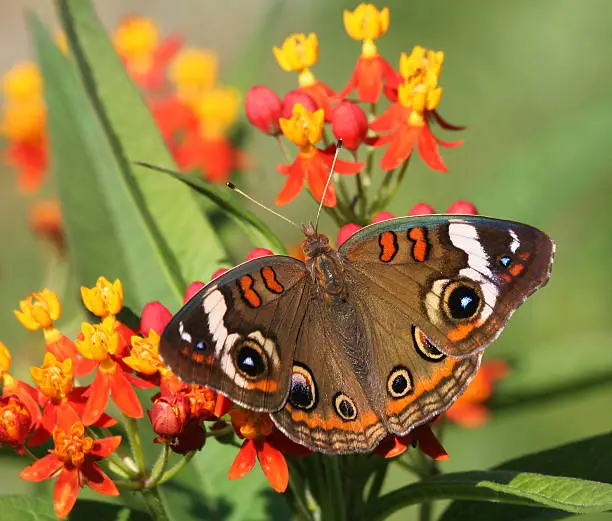“Butterflies are free, and they dance in a garden of love.” – Debasish Mridha
The Common Buckeye Butterfly (also known as ‘Junonia coenia’) is a charming species known for its notable eyespots and sophisticated wing patterns. These butterflies are fun to observe and not only that, but they also carry important symbolic meanings through various different cultures. This article will jump into the pool of the Common Buckeye Butterfly meaning, symbolism, and its life cycle. Providing comprehensive, detailed and informative insights into its biological and ecological aspects.
Meaning and Symbolism
“A butterfly is a reminder that we are like them. We go through changes, spread our wings, and fly.” – Anonymous
Common Buckeye Butterfly Meaning
“The caterpillar does all the work, but the butterfly gets all the publicity.” – George Carlin
The Common Buckeye Butterfly is commonly linked with ‘vision’ and protection. It’s well known, eyespots are believed by some people to provide protection from predators, symbolizing defensive means. These eyespots also serve as a figure of speech for intuition and awareness, encouraging the people who have experienced this butterfly to remain vigilant and perceptive in their daily lives.
Common Buckeye Butterfly Spiritual Meaning
“Butterflies are the souls of summer flowers.” – Sir Robert Gilbert
In spiritual contexts, the Common Buckeye Butterfly represent different symbolisms. Like in Native America, this butterfly is seen as a symbolism for hope, renewal and beauty. This butterfly can be a metaphor for a whole world of traits like resurrection, growth, change and good fortune etc.
As with other butterflies, its metamorphosis from caterpillar to butterfly symbolizes personal growth and spiritual awakening.
Buckeye Butterfly Symbolism
“The butterfly does not count years but moments, and has enough time.” – Rabindranath Tagore
Across various cultures, the Buckeye Butterfly is thought highly of because of its beauty and symbolic meanings. The butterfly’s enchanting colors and patterns are also seen as symbols of joy and creativity, inspiring artistic expression and positive energy.
Biological and Ecological Aspects
“The butterfly is a flying blossom, the blossom a tethered butterfly.” – John Keats
Common Buckeye Butterfly Facts
- The Common Buckeye Butterfly is easily recognizable by its particular eyespots and brown wings decorated with orange and white markings.
- They have a wingspan of about 2 to 2.5 inches.
- These butterflies are diurnal, meaning they are active during the day, and they prefer open, sunny habitats such as fields, gardens, and meadows.
- The Common Buckeye Butterfly is found throughout North America, from southern Canada to Mexico, making it a widespread and familiar species.
“Butterflies are the laughter of the sun.” – Anonymous
Common Buckeye Butterfly Range
“Butterflies are not only a symbol of transformation but also of new beginnings and fresh starts.” – Anonymous
The Common Buckeye Butterfly has a broad range across North America. It is most commonly found in the southern United States and extends its range into Mexico. During warmer months, these butterflies can be seen as far north as southern Canada. They prefer open areas with plenty of sunlight and are often spotted in fields, gardens, roadsides, and meadows.
Common Buckeye Butterfly Life Cycle
“To see a butterfly is to glimpse a bit of magic, to hold one is to hold a piece of heaven.” – Anonymous
The life cycle of the Common Buckeye Butterfly consists of four stages: egg, larva (caterpillar), pupa (chrysalis), and adult.
- Egg: Female butterflies lay eggs singly on host plants. These eggs are tiny, spherical, and pale green, hatching within a few days.
- Larva (Caterpillar): The caterpillar emerges and begins feeding on the host plant. Common host plants include plantains, snapdragons, and toadflaxes. The caterpillar stage lasts for about two to three weeks, during which the larvae undergo several molts, growing larger each time.
- Pupa (Chrysalis): After reaching full size, the caterpillar forms a chrysalis, attaching itself to a suitable surface. The pupal stage lasts for about one to two weeks. During this time, the caterpillar undergoes metamorphosis, transforming into an adult butterfly.
- Adult: The adult butterfly emerges from the chrysalis, ready to begin its life of feeding, mating, and laying eggs. Adults typically live for a few weeks, during which they can lay multiple batches of eggs.
Common Buckeye Butterfly Caterpillar
“The butterfly is proof that you can go through a great deal of darkness yet become something beautiful.” – Anonymous
The caterpillar of the Common Buckeye Butterfly has distinctive characteristics like black and orange stripes and small white spots. It has short, branched spines running along its body, giving it a somewhat ‘prickly’ appearance. These caterpillars are basically insatiable feeders, primarily consuming the leaves of host plants. The caterpillar stage is extremely important for growth and development because during this time the nutrients consumed are stored for the later stages of metamorphosis.
What Do Common Buckeye Butterflies Eat
“Butterflies are nature’s confetti, thrown upon the world in celebration of life’s beauty.” – Anonymous
Adult Common Buckeye Butterflies primarily feed on nectar from a large variety of flowers. Some of their favorite nectar sources are asters, zinnias, and milkweed. The nectar provides essential energy for flight and reproduction, just like how food provides essential energy to us humans to do day to day task. Additionally, adults sometimes feed on sap, rotting fruit, and moisture from damp soil, which provide minerals and nutrients not found in nectar.
Conclusion
The Common Buckeye Butterfly is a remarkable species, admired for its beauty and symbolic meanings. From its significant eyespots to its transformative life cycle, this butterfly offers valuable insights into the natural world. Understanding the Common Buckeye Butterfly’s meaning, symbolism, and biological aspects enhances our appreciation of this fascinating creature. Conservation efforts are vital to ensure that future generations can continue to enjoy and learn from the Common Buckeye Butterfly. By protecting their habitats and promoting biodiversity, we can help preserve the delicate balance of our ecosystems. Not, only that, but butterflies in general are awesome for our environment, they pollinate all sorts of flower; taking care of our gardens.
“A butterfly lights beside us like a sunbeam, and for a brief moment its glory and beauty belong to our world.” – Anonymous

